Mechanoresponsiveness 38
Mechanoresponsiveness 38
Jean Luc Cornille
“In politics, stupidity is not a handicap.” (Napoleon Bonaparte)
History proves that not only Napoleon was right, but that the term “stupidity” was an understatement. Politicians declare that animals don’t feel pain, emotion, love. Charles Darwin stated the exact opposite; “There is no fundamental difference between man and animals in their ability to feel pleasure and pain, happiness, and misery.” 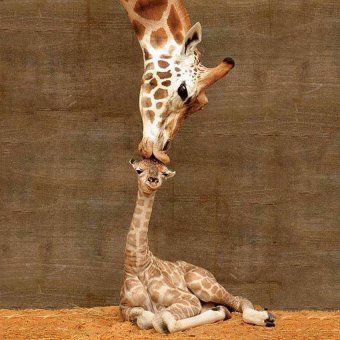 The political statements are of course directed by personal failure and corruption. Politicians see a sense in destroying the planet for their personal gain or the benefit of their sponsors. However, their dumbness rests on our acceptance of being dumber. “The price of apathy towards public affairs is to be ruled by evil men.” (Plato).
The political statements are of course directed by personal failure and corruption. Politicians see a sense in destroying the planet for their personal gain or the benefit of their sponsors. However, their dumbness rests on our acceptance of being dumber. “The price of apathy towards public affairs is to be ruled by evil men.” (Plato).
No one, in the political world, is going to give us the education that we need to overthrow them, but animals, and in our specific world horses, can teach us the values that politicians have interest to destroy, respect, ethic, decency, honesty, compassion and intelligence. According to Jim Butcher, evil is less a threat than stupidity.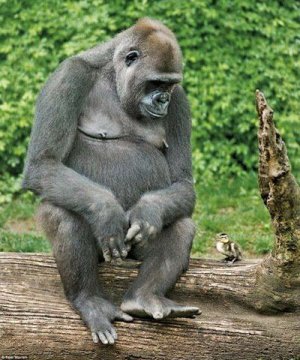 "Evil isn’t the real threat to the world. Stupid is just as destructive as Evil, maybe more so and it’s a hell of a lot more common. What we really need is a crusade against Stupid. That might actually make a difference.” (Jim Butcher)
"Evil isn’t the real threat to the world. Stupid is just as destructive as Evil, maybe more so and it’s a hell of a lot more common. What we really need is a crusade against Stupid. That might actually make a difference.” (Jim Butcher)
Decarpentry hinted on the subject of stupidity drawing a parallel between politics and equitation. “In equitation as in politics, we should beware of over-simplification; this nearly always complicates matters in the end.” (General Decarpentry, Academic Equitation) Marketing strategists sell simplicity, because they see a sense in destroying horses and riders for profit. The equine biological mechanism is everything but simple. Superbly efficient, subtle, smart, marvelously complex, intelligent, but not simple. The price of riders’ apathy in the face of simple theories is lameness, poor performances and suffering.
Riders want it simple. Not only they see a sense in destroying their horses with simplistic theories, but they resist any advance in scientific knowledge questioning their beliefs. Isaac Newton discovered gravity in 1687, The attraction of gravity is pulling the horse’s neck and head down to earth, but anyone promising that the lowering of the neck does stretch the upper neck muscles will find followers dismissing the attraction of gravity. Many refute science, claiming that riding is about feeling and intuition. The problem, paraphrasing William James, is that intuition is not infallible. “Intuitions, contrary to much popular lore, are not infallible. Cognitive scientists treat them as quick first assessments of a given situation, as provisional hypotheses in need of further checking.” (William James)
Linus Paulin defined scientific research as “Factual documentation of test hypothesis.” But many adopt the provisional hypotheses without further checking. Indeed, they resist further checking by fear that further checking might expose the falsehood of their belief. They open the umbrella of tradition, claiming that they perpetuate the classical “School of Versailles,” or other school. Interestingly. General Decarpentry wrote in the preface of his Academic Equitation, (1949) “In 1814, when Saumur was founded, a “Manege Academique” was established there and entrusted to civilian riding masters who, after M. de Chabannes had left, all claimed to be heirs to the Versailles tradition. However, not one of them had ever been a member of the personnel of the Grande Ecurie or of the Petite Ecurie.”
“Each day should be spent finding beauty in flowers and talking to animals.” (Nicholas Sparks) 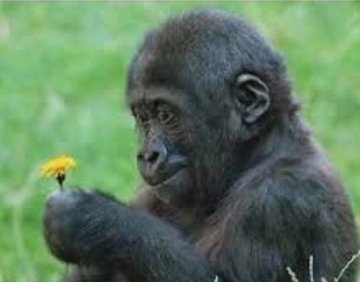 Opening our mind to wonder is the antidote against having a mind closed by beliefs. Equine athletic performances are complex movements regulated by structures. Simple beliefs regard the excellence of the horse complex movements as the result of the rider’s correct aids. The theory is not even simple; it is simpler. “Everything should be made as simple as possible but not simpler.” (Albert Einstein) The horse achieves complex movements combining multiple parts into continuous mechanical loops. “In the body, close kinematic chains are nested modular units of different size that make up an integrated movement system that extends through the whole body and act in synergy with the nervous system.”(Dr. Betsy Uhl, DVM, PhD, Dip, ACVP)
Opening our mind to wonder is the antidote against having a mind closed by beliefs. Equine athletic performances are complex movements regulated by structures. Simple beliefs regard the excellence of the horse complex movements as the result of the rider’s correct aids. The theory is not even simple; it is simpler. “Everything should be made as simple as possible but not simpler.” (Albert Einstein) The horse achieves complex movements combining multiple parts into continuous mechanical loops. “In the body, close kinematic chains are nested modular units of different size that make up an integrated movement system that extends through the whole body and act in synergy with the nervous system.”(Dr. Betsy Uhl, DVM, PhD, Dip, ACVP)
One might reject the fancy words and declare the statement to be “above my head,” but one would easily understand the sentence and better train one’s horse by letting the statement entering one’s head.
The first evidence underlined by the statement is that gaits and performances are more complicated than they look. Already there, ultraconservative will shut off their brain. 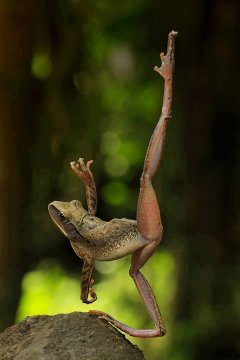 The ones who think that teaching this move to a frog would simply demands taping the frog’s legs in such posture for two hours every day, will refuse any complexity. Of course, it is ridiculous, but not more ridiculous than tying the horse head in a given posture in the stall or at the lunge line and thinking that the static restriction might be a lesson. In the same line of thought or lack of thought, “dressage for dummies,” promote half halt as a tool shifting the weight over the haunches. It has been demonstrated since decades that such backward shift of the weight does not exist.
The ones who think that teaching this move to a frog would simply demands taping the frog’s legs in such posture for two hours every day, will refuse any complexity. Of course, it is ridiculous, but not more ridiculous than tying the horse head in a given posture in the stall or at the lunge line and thinking that the static restriction might be a lesson. In the same line of thought or lack of thought, “dressage for dummies,” promote half halt as a tool shifting the weight over the haunches. It has been demonstrated since decades that such backward shift of the weight does not exist.
Close kinematics chains are very energy efficient. They are part of the kinematics wonders rendering the horse so elegant and efficient. Close kinematics chains orchestrate the whole horse’s physique at a high level of efficiency. Equine athletic training, as well as riding techniques, need to evolve from making the horse do it to understanding how the horse does it. The focus would be then on an education allowing the horse to perform soundly and at its utmost potential instead of exploiting the horse talent until the repetition of stressful performances with a dysfunctional physique induces lameness.
If it was as simple as restoring the natural reflexes, everyone would be an expert in academic equitation. In reality, natural reflexes are ill adapted to the demands of athletic performances and, like in every other athletic specialties, efficiency, but also ethic and decency, resides in the knowledge allowing to prepare the athlete for the athletic demand. If it was as simple as having the hind leg over reaching the foot print of the foreleg, rushing the horse forward would work, but, if we look at the kinematics chain allowing greater engagement of the hind leg, the hoof placement is a “simpler” detail more likely to create stifle problem than sound performance. The forward swing of the hind leg commences with a pendular movement of the femur around the hip joint. While rotating around the hip joint, the femur undergoes simultaneously an inward rotation around the tibia. This rotary movement of the femur occurs toward the outside, (medial-to-lateral,) during the swing phase and toward the inside, (lateral-to-medial,) during the support phase. As the protracting hind leg swings forward, the stifle extends and the usual medial-to-lateral rotation occurs. If greater engagement of the hind leg is created without adequate dorso-ventral rotation of the pelvis, the stifle might extend beyond its safe limits exposing the stifle joint to upward fixation of the patella. “If the extension is carried on beyond about 143-145°, there is a final lateral-to-medial twist, which rotates the patella medially and hooks the medial patellar ligament over the medial ridge of the femoral trochlea. The stifle is “locked” and flexion prevented.” (James R, Rooney, Biomechanics of lameness in horses, 1975)
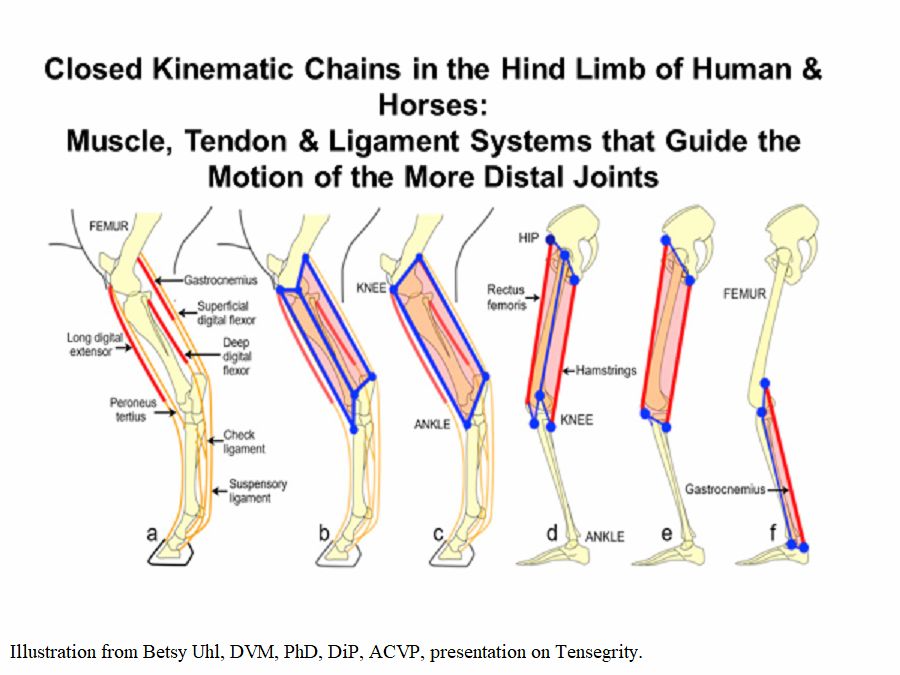
The equine stifle is the equivalent of the human knee. In human, eccentric contraction of the quadriceps muscle dissipates energy to decelerate the knee immediately before the heel strike. Failure to decelerate the leg can generate forces as large as 65X body weight. The energy produced by normal walking would tear all the ligaments in the human knee if it was not absorbed by muscular activity. Training techniques such as lowering of the neck and/or rushing the horse faster than his natural cadence, reduce the mobility of the lumbar vertebrae and consequently proper dorso-vental rotation of the pelvis. Most horses adapt impacting the alighting hind leg earlier. The kinematic abnormality reduces the decelerating activity of the hind legs muscles, including the quadriceps. The stifle is then exposed to damaging forces. For centuries, horses have performed out of their talent in spite of riding and training techniques failing to prepare their physique for the effort. Many injuries could be prevented if, instead of “making the horse do it,” our equitation and training technique focused on preparing the horse’s physique for the effort. Instead of resisting new knowledge because it questions old belief, we owe to the horse to do better. “I did then what I knew to do. Now that I know better, I do better.” (Maya Angelou)
“It makes little sense that cartilage could withstand the bounding of 3-6 X body weight crashing up and down on it over a sustained duration such as someone running a marathon. I am not aware of any tissue that could withstand such compressive forces.” (John Sharkey) The structural integrity of the joints is preserved by tension, (tensegrity.) Tensegrity disperses forces and protect against the transmission of compression across the joints. Fascia also protect the joints from compressive forces as fascia under tension is strong enough to maintain the integrity of the joints. Tensegrity is the fundamental principle of sound equitation. Harmonic tensegrity is the real relation between human and equine. There is no room for stretching, slackness and lack of muscle tone, (relaxation.)
Even Gods listen to animals, knowing that respecting animals and learning from the animals’ biomechanical marvel prepare them for their divine duties. The gods who demand animal sacrifices are just human fabrication.  Learning form the horse’s biomechanical marvel is an extraordinary process where we become the person that we always should have been. David Bowies attributed our evolution to aging. “Aging is an extraordinary process where you become the person you always should have been”. (David Bowie)
Learning form the horse’s biomechanical marvel is an extraordinary process where we become the person that we always should have been. David Bowies attributed our evolution to aging. “Aging is an extraordinary process where you become the person you always should have been”. (David Bowie)
We can learn faster and further learning from the mistakes of others, “Learn from the mistake of others. You can’t live long enough to make them all yourself.” (Eleanor Roosevelt) We can learn faster and further wondering on the complexity and efficiency of both, our horse and our own body. “There is more wisdom in your body than in your deepest philosophy.” (Friedrich Nietzsche) For centuries the horse has been willing to teach us how to teach him. For centuries, the horse has told us about his difficulties to perform hoping that we will develop our knowledge, (know better,) and became capable to teach him a more efficient way to use his body, (do better).
Jean Luc Cornille 2018


 twitter
twitter facebook
facebook pinterest
pinterest linkedin
linkedin